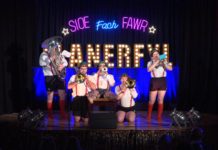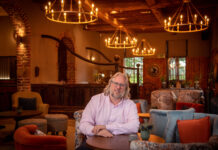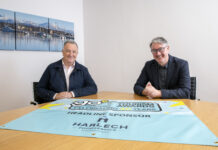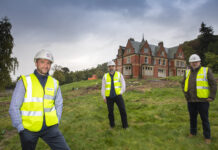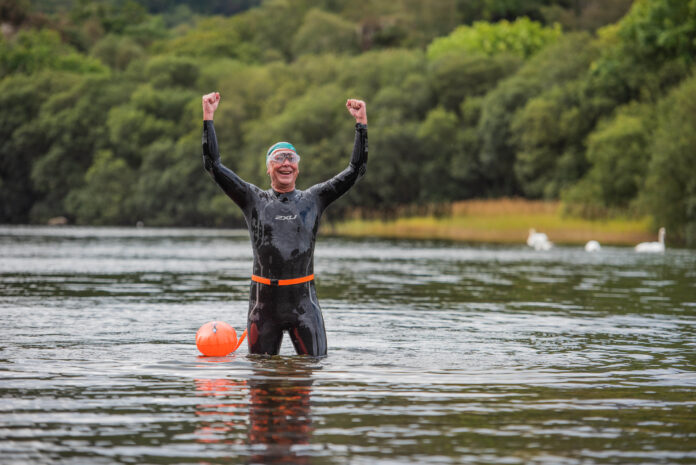An epic swim across 60 kilometres of some of the wildest water in Wales’s seas, rivers, lakes and reservoirs is no birthday party – as TV presenter Gaz Top discovered.
Gareth Jones: Nofio Adre (Gareth Jones: Swimming Home) – tells the tale of how the St Asaph-born star of ITV shows like How 2 with Fred Dinenage and Carol Vorderman and The Big Bang tackled two-metre waves in the Bristol Channel, a Mid Wales reservoir where Dambusters explosives were tested and the lake which swept away a village in the Conwy Valley.
To get the energy to fuel his efforts Gareth, was advised by nutrition experts from Bangor University to gorge up 5,000 calories a day.
His eating regime consisted of a massive breakfast bowl of muesli kicking off a daily intake of carbohydrates and protein that was rounded off by a starter, two main courses and a pud in the hotel each evening.
The Welsh-speaker from Holywell, who now lives in trendy Stoke Newington in London, dreamt up the project to celebrate his 60th birthday and it has been brought to life by award-winning Caernarfon-based international TV company Cwmni Da.
He bodysurfed ashore in Porthcawl, suffered severe stomach cramps which nearly derailed the project near Llanelli, shared frigid Llyn Tegid with a fish from the Ice Age and was swept down the River Conwy.
The three-part series has been produced by Cwmni Da and will be shown on S4C, with the first programme going out at 9pm on Friday, October 29, and other episodes being shown on consecutive Fridays.
Gareth – whose the nickname Gaz Top came from his early days as a roadie with Welsh rockers The Alarm – had always been a strong swimmer and when he started taking his new-born son swimming in London 20 years ago, he was soon up to 100 lengths a session himself.
He said: “Basically I’m a frog from the waist down. I’ve got flat feet so I can’t run but I can swim and this idea of doing this to mark my 60th came about because I wanted to reconnect with Wales, the land that made me, after so long living in London.
“I put the idea to S4C and they were keen and I was lucky enough to have Cwmni Da as the production company and they’ve been absolutely brilliant in organising everything because you need safety boats and water safety experts as well as a team for the cameras and sound.
“They threw me into the sea about 700 metres from the beach at Porthcawl and I virtually surfed in on two-metre waves in about 20 minutes.”
Things got tougher after that as two days into his epic challenge he woke up in the early hours of the morning with agonising stomach cramps: “I don’t know whether I swallowed water or ate something dodgy but after two hours of cramps I threw up and that carried on through the night.
“I just had no strength. I couldn’t get out of bed, never mind into the water. I just had to rehydrate and eat and the next morning I felt fine and was able to carry on.”
That high calorific content was key and Gareth reckons he was eating twice times a man’s normal daily intake of about 2,500 calories to help him cope with the rigours of swimming an average of four kilometres on 15 days out of the 20 he and the crew spent on the trip.
Programme One sees Gareth in such varied locations as Llanelli’s North Dock, the River Teifi, Gwent’s Llandegfedd Reservoir, Parc Bryn Bach, Tredegar.
The second in the series covers Mid Wales with the Elan Valley and Claerwen Reservoirs, the River Dovey, Llyn Mwyngil, at Tal y Llyn, and Llyn Tegid, Wales’s largest lake, at Bala.
The final leg pits Gareth against North Wales’s great lakes, from Snowdonia’s Trawsfynydd, Eigiau, the great glacial expanses of Padarn, Gwynant and Mymbyr tiny Llyffant, the highest lake in Wales at over 2,600 feet, Llyn Brenig, up on the Denbigh Moors, and the swift-flowing River Conwy.
Eigiau was the site of the Dolgarrog disaster in 1925 when the dam failed and billions of gallons of water inundated the village below, killing 16 people – the death toll would have been higher but most of the inhabitants were watching a film show in the village hall, fortunately on higher ground.
Gareth said: “We had to get permission to swim in Eigiau where the reservoir is now a lake, it was one of a number where we had to get special permission.
“It just shows the power of the water. I was taking on something genuinely dangerous and I was overwhelmed to be alive at the end of it.
“I also tackled Brenig and that was one of the toughest. It was pretty much like swimming through molasses.
“I was pretty much acclimatised to cold water by then but two degrees C really reduces your efficiency, it just sucks the energy out of you.
“Llyn Tegid was unbelievable. It’s just over six kilometres long and famously cold and deep, deep enough and cold enough to be home to the gwyniad, a species of Arctic char.
“My father almost drowned when he was sailing on the lake years ago and I trained specially for it so it was emotional for me to be in the water there.”
Along the way he met with locals who shared their knowledge of the waters of Wales, including Owen Roberts in Mid Wales who dropped in at the Elan Valley Reservoir.
He said: “Many people believe the lake here was where Barnes Wallis’s bouncing bomb was tested before the Dambusters squadron used it to blow up the Mohne and Edersee dams in the famous World War Two raid.
“But that’s a myth though there is a connection. They actually blew up a small dam here to find out how much explosive they’d need to destroy the German dams.”
He also met with locals who shared their knowledge of the waters of Wales, including Keith O’Brien, from Trawsfynydd, who chatted to Gareth alongside the reservoir created there in the 1920s by McAlpines to serve the Maentwrog hydro-electric power station.
He said: “There were plenty of Irish navvies and there was an army camp down the road and that made for quite a combustible situation at the weekends – Traws had to have two policemen and quite a few of the navvies ended up sleeping it off in the cells there.
“There were no great protests about the reservoir being built. The land did have over 20 homes on it and a chapel but in the Twenties people were glad of the work in a depression.
“Before it was flooded it was a peat bog, a mawnog, and people would cut peat there to burn through the winter to keep warm.
“It’s Wales’s second largest lake and water from it was used to cool the condensers in the Trawsfynydd Nuclear Power Station Power Station which was supposed to make the lake warmer for swimming in which I did as a boy, as well as make the fish in the lake bigger.”
The series took three weeks to film and Cwmni Da producer Huw Erddyn said: “Gareth’s food poisoning on day three was a challenge but before that, in the Bristol Channel, he might have found the surf carrying him very helpful but it was a nightmare for us trying to film with the boat bucking around in the waves.
“Llyn Tegid was a long swim but the longest were on the Teifi and the Conwy, both at over eight kilometres, and we planned to finish at the Liverpool Arms on Conwy harbour.
“It’s a good place to stop for fish and chips and that’s exactly what we did.
“I know Gareth was worried about the swim in the Teifi, the last one for the first programme and over 8 kilometres just after recovering from the stomach bug.
“It was slack water and so he had to really swim for the first half which was tough but we had a good safety team throughout with Dilwyn Sanderson Jones as our lead safety, who does safety work for Bear Grylls. We had safety canoes, kayaks or a rib in the water at all times.
“We met some great people along the way too and we heard some wonderful stories about Wales.”




